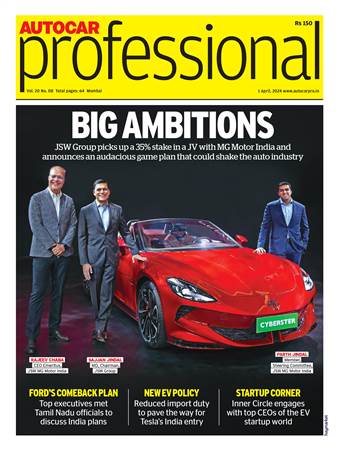Innovation and vision for a changing auto world
The coincidence of the 2008 energy crisis and a global economic downturn changed the automotive industry as we know it and forced a change in vehicle purchase behaviour.
The coincidence of the 2008 energy crisis and a global economic downturn changed the automotive industry as we know it and forced a change in vehicle purchase behaviour.
Overlayed on this fundamental change was the growing uncertainty over which powertrain or future fuel path to invest in, coupled with a shift in direction of the car ownership and usage models, and a completely new attitude towards brand and brand loyalty from the younger generation who have grown up amidst the telecommunications revolution.
In the resultant turmoil a few automotive giants ran over the edge of a commercial cliff and the automotive sector has emerged as an industry which is now focusing on a new direction in both their business models and their product strategy.
Manufacturers are now having to compete in new dimensions in an arena where the old business model of high investment, single-model strategy and very high annual volumes has largely collapsed. The new direction calls for innovation and modularisation in both manufacturing and product. When a modular architecture is introduced, integration will no longer be a crucial factor in the success of the business, and we will open up multi-niche opportunities.
Against this complex background of change and disintegration of business models, opportunities are being created for both OEMs who are open to change and new entrants to the sector alike.
This new industrial and business revolution and the drive towards lower global emissions is producing innovations in very nearly all the areas of automotive design, manufacture and business strategy. The internal combustion engine has seen a multiple of small but significant developments in the last eight years and is now plateauing near the top of the parabolic curve of cost over gain.
The powertrain sector is dramatically divided over direction with a particular lean towards electrification, but currently full life cycle analysis shows that we need generation 2 battery technology and cleaner energy production for this is to be even close to becoming the silver bullet we are seeking.
Ethanol and bio fuels come with their own background problem and are almost entirely geography dependant, whilst hydrogen needs a low energy manufacture breakthrough to be a realistic alternative. Tesla has emphatically demonstrated that infrastructure will not be a problem if the product is available and desirable.
There are a multiple of smaller areas in vehicle design which collectively can make a significant contribution to our vision of a more efficient, cleaner mobility model. Amongst these are tyre design and technology which is an important factor in city driving where rolling resistance accounts for 18 percent of the vehicle losses and aerodynamics for inter-city driving – an area of development which is currently being held back by commercial targets and market-driven style. We have some headroom in the area of friction reduction and lubricants and this is one area that benefits from motor racing technology.
The final frontier in the world of design is lightweighting and this is the sector where we will see the most innovation, both in materials technology and manufacturing.
In spite of the lessons learned following the 2008 collapse, cars have steadily grown larger and heavier with each model change. Companies such as JLR have chosen a route based on a fundamental material change from steel to aluminium whilst car producers such as Mazda have taken a more holistic approach by saving weight with footprint reduction and complete vehicle mass reduction by design. BMW and Alfa Romeo have bravely selected the expensive, monolithic carbon fibre route which borrows material from racing cars but is cost and volume limited. Most other car companies pay lip service to lightweighting by opting for a material change on single components.
Here at Gordon Murray Design we have been working on a manufacturing concept called iStream, which is based on racing car technology, but not racing car materials which therefore side steps the limitations of cost and volume.
DISRUPTIVE BUT ATTRACTIVE PROCESSOR
The iStream process is disruptive enough to be attractive as an enabler for new entrants to the automotive sector, but not enough to exclude adoption by an existing OEM. The holistic system is not simply a step change in vehicle weight reduction, but reduces capital investment massively and allows for a completely modular approach to car design and platform strategy. iStream is the first weight reduction system to reduce rather than increase investment and product costs whilst offering higher levels of safety and durability. This high- volume manufacturing system represents the largest and most significant step change since Henry Ford invented the mass production car build line.
Another sector where we will face step change and experience innovative advances is in the mobility and lifestyle arena. As an ever larger percentage of the global community gravitate towards urban living, we will see a shift in car design and usage. Emission damage with its subsequent legislation changes, growth in public transport and car sharing, the car ownership model and congestion will result in more ‘fit for purpose’ rather than ‘multi-purpose’ cars being produced. Self-drive cars will probably appear at some time in the future when the towering spectre of liability and product liability has been driven out. Energy production technologies will dictate different directions from a geography point of view and finally interconnectivity will be king.
The automotive industry has a lot of catching up to do to achieve, match and adopt the innovation and strategy we experienced during the connectivity and telecommunications revolution.
The rate of acceleration of change and innovation has been exponential since 2008 and we are experiencing a point in time where we know that the future of our automotive world will never be the same again.
RELATED ARTICLES
'ADAS' crux lies in its proactive approach to safety enhancement': TaMo's Mohan Savarkar
Savarkar writes about the role of Active Safety Technology and ADAS in Compact Cars in augmenting inclusive vehicle safe...
Maintenance 101 for your electric two-wheeler, a cheat sheet for a breezy ownership experience
The experience of owning electric bikes is new, and remaining informed, aware and proactive will help in becoming better...
How technology can advance traffic enforcement for safer roads
By ensuring that only qualified drivers occupy the roads, authorities can substantially reduce the risk of accidents ste...





 19 Jan 2015
19 Jan 2015
 7217 Views
7217 Views





 Autocar Pro News Desk
Autocar Pro News Desk




